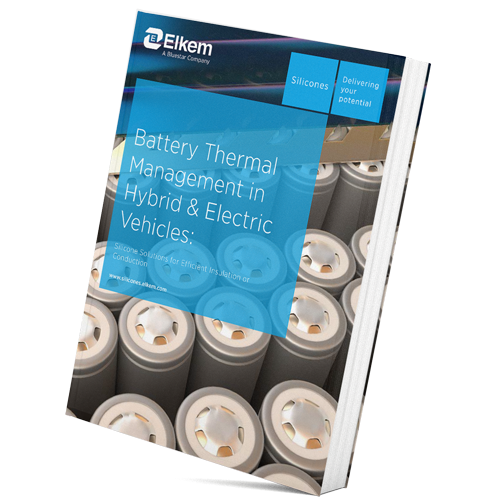- Magazine
- Mobility & transportation
- Thermal Management Materials: A Must for EV Batteries
Thermal Management Materials: A Must for EV Batteries
Over two million electric vehicles (EVs) were sold around the world in 2018. In turn, this started a wave of performance demands for EV batteries. Are you aware there are thermal management materials that can provide EV battery reliability-enhancing and heat-dissipating performance solutions?
Or that thermal management materials provide EV batteries with enhanced performance and safety? It almost seems like a futuristic world when you’re dealing with thermal management materials for EV batteries. Because the EV batteries thermal management solutions evolve all the time, it’s vital you stay current and updated on how they are now making a difference in multiple markets through various applicational uses.
Read on and discover more about thermal management products and how its impacting markets and applications. These impacts range from the automotive industry, industrial markets, datacom companies, the computing worlds, to more varied and cross-sectional industries.
Thermal Management Materials
In the broadest and most expansive definition, the term thermal management includes but isn’t limited to thermodynamics, heat, power transfers, insulation, conduction and convection. The performance of any EV or HEV battery highly depends on the battery capacity. What’s more, it’s the thermal management materials that are a must for EV batteries because they better the battery’s operating performance and safety.
There’s no getting around thermal management activities impacting critical processes of the EV Battery. Is there a way to master the EV battery ongoing challenges always present in thermal performance? Within the battery’s performance and safety criteria you already have the charge and discharge capacity is directly influenced by the EV’s battery temperature.
The temperature of the battery is of crucial importance when dealing with the performance of the battery. Thermal management materials and their impact on EV batteries are a prime consideration because EV batteries reach their last days once they reach a 20 percent capacity loss or 30 percent internal resistance growth. When this occurs, both active and passive battery thermal management systems are what almost every engineer, regardless of their industry, tries to overcome.
Thermally Conductive Materials
Almost all thermally conductive materials are made to help control the temperature to ensure optimal EV battery performance. This helps improve the lifespan of the battery. One of the best thermally conductive materials is silicone.
There are times you may have to choose between polyurethane, silicone or another polymer. When that happens, it’s essential to have the latest and most significant data available for your consideration before you make a decision. That’s because you’re seeking optimal battery performance and safety while ensuring electrical and thermal connections.
These connections ensure the battery breathes during discharge gives you the best recharge cycles. Some thermal management materials help prevent delamination and deformation and help cool battery packs. It’s essential to have a thermal management solution that helps accommodates the dimensional changes needed by EV batteries while giving you higher return energy potential.
Most foam cushioning can resist EV battery permanent deformation when it’s processing compressive loads.
Thermal Conductivity
Almost every thermal management solution is looking to optimize a more extended range in EV batteries. Most of the time, your regular gap filler or thermal pad doesn’t meet the new thermal management solution designs. If you add to that equation, an EV battery that has a part that needs to be secured to a cooling attachment, then you’ll inevitably have thermal conduction becoming an issue.
To help address this issue, thermally conductive adhesives have become the answer in solving EV structural and thermal requirements for battery productivity and safety. The rule of thumb in EV battery thermal conductivity is the higher the need, the more expensive the solution. But sometimes that’s the only way you can get a material solution that fits your needs.
A structural adhesive can help ensure an EV battery’s strong bond, so it remains securely attached. When dealing with the thermal conductivity for EV batteries, the temperature has a direct bearing on the EV battery’s performance. The better the thermal management material that’s used helps keep temperatures drops to a minimum, which means you have optimum battery performance.
Battery Thermal Management
A battery’s life is doubled if you can find a way to reduce the EV battery’s temperature. Every ten degree Celsius reduction gives you an EV battery that has doubled its lifespan. Finding thermally conductive material for your EV battery needs to be of prime importance to you, so you aren’t bombarded with constant EV low-life battery issues.
The EV battery array, once overheated, can catch fire or cause heating issues with other components causing a negative domino effect. That’s why once you decide your battery thermal management material, you should strongly consider silicone foam because of its intrinsic insulation characteristics. What’s even better is silicone foam as a thermal management material is a fire retardant that has self-extinguishing components within it.
It goes without saying that silicone foam as your battery thermal management solution may have a higher price than polyurethane. But since the silicone lasts so long, your EV battery quality and lifespan are vastly improved.
EV Battery Performance and Safety
When you need to know the most recent developments in battery performance and safety, there are many thermal management materials to deep-dive through as well as related topics that all hinge on one thing. The one thing is optimizing the EV battery performance levels while maintaining the safety criteria needed. There is a lightweight thermal management material you can consider that helps minimize heat transfers, so you scale up your EV battery performance.
Even a 10 percent reduction in vehicle weight can result in a 6% – 8% energy economy improvement, which in turn allows you to reduce the load the EV battery carries. Every thermal energy management system ensures improved EV battery performance and safety.
Also, the thermal energy management system ideally will have some temperature variations within the EV battery cell and module. When the EV battery has compact and lightweight battery performance solutions, it helps reduce the overall cost and is easier to use in most cases. If you can ensure you have a provision to deal with hazardous gases, this helps the EV battery’s ventilation needs.
Pack-Level and Cell-Level EV Batteries
It’s a puzzle that electric vehicles have come so very far in the marketplace and still show forward movement in growth and development while the EV battery is almost standing still. There are thermally conductive materials being introduced to the EV battery every day. To better ensure the continued development of optimizing better EV battery performance and safety, EV batteries must be analyzed at the pack-level and cell-level.
Researchers, users, and those who want to stay in the know of how to optimize their EV battery performance better should know the ambient temperatures and C-rate are the two most important factors that affect the thermal management solution. The best thermal management system will deal with the EV battery’s thermal battery factors in air cooling, liquid cooling, and phase change material cooling. Thermal management systems always attempt to counter environmental changes in EV batteries. Currently, there is a need to develop more passive techniques that will increase EV battery temperature uniformity while reducing additional power requirements.
The Way Forward for EV Battery Thermally Conductive Materials
When you’re interested in learning more in a content ecosystem that provides a staggering amount of sub-content and answers to long-held questions in EV battery performance and safety, there’s a place you can go. The best in thermal management materials are ready for you when you reach out to Elkem Silicones, a Blue Star Company. Elkem Silicone is one of the world’s leaders in integrated silicone manufacturing. Elkem Silicones offers cutting-edge innovation that keeps development and growth, leading the way in EV batteries now and in the future. Whether your silicone or EV battery needs have specific solutions or a prototype quote, Elkem Solution can move forward into the future with you for all your EV battery needs.


